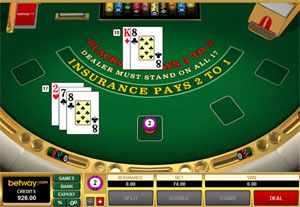The Real Meaning of Percentages in Blackjack
When researching casino game payouts, odds and probability or strategies you'll generally find certain aspects such as the house edge, player margins or payout rates are expressed as percentages. For example, by playing according to basic blackjack strategy the average player is able to reduce the house edge to less than 1% depending on the variant played.
This may seem fine and well but it does seem a little abstract to some players who wonder what these percentages actually equate to in terms of monetary values. Here we'll take a look at this concept and attempt to better explain the real meaning of percentages in terms of actual monetary values to you as a player.
Before we look at actual values applied to a few casino game scenarios, it is important to note that the percentages regarding house advantages and player returns are greatly influenced by the size of a player's wager as well as the rate at which they play. For example in Blackjack, more hands are dealt at tables with fewer players and this will affect a player's average loss per hour. This is due to the fact that the more hands you have to play, the more you expose your bankroll to the casino, and the more you'll generally lose.
Also, the quality and skill of a player has an effect on the house edge. Two decades ago it was estimated that the house edge faced by the average player was usually between 2 to 2.5%. These days, even though games are more challenging than ever, player knowledge and skill has increased and most casino executives put the house edge at between 1.5 and 2% because of this.
Now let's take a look at a few gambling scenarios using different wager values and game speeds to see how these percentages translate into dollars and cents.
Let's assume you play a blackjack game at $10 per hand and play 50 hands per hour. You're effectively risking $500 per hour. If you're a sound basic blackjack strategy player, and the rules of the game ensure a 0.5% edge against you, your average loss will be $2.50 per hour. If however your strategy allows the house a 1.5% edge, your losses will be $7.50 per hour and if you don't play according to strategy and face the full 2% edge, then your losses will equate to $10 per hour. As the value of your wager increases, so will your losses.
Now if you play 100 hands per hour, wagering $10 per hand, you'll be risking $1000 per hour and depending on the strength or weakness of your game play strategy, your losses will be as follows:
- 0.5% house edge = $5 loss per hour
- 1.5% house edge = $15 loss per hour
- 2% house edge = $20 loss per hour
Generally however playing online blackjack seriously at a fairly rapid pace or going head-to-head with a dealer will mean that you play in excess of 200 hands per hour which means even greater potential for risk and losses. This is because the larger the wagers you make and the faster the game speed, the larger the actual dollars and cents differences between a strategic player and average player will become, which shows just how important it is to master sound basic strategy if you want to have any chance at extending your game play time and enjoyment at the casinos.

